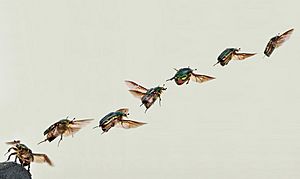Movement facts for kids

Movement, or motion, is the state of changing something's position—that is, changing where something is. A flying bird or a walking person are moving, because they change where they are from one place to another. There are many kinds of science and math related to movement.
For example, thanks to the work of scientists including Galileo Galilei and Albert Einstein, we know that position and motion are relative. This means that everything's position depends on where they exist in relation to other things. For example, a ball is 5 feet away from a box, 3 feet away from a chair, and a foot away from a table. According to Einstein, the ball's position means how far the ball is from other things, so by telling you how far the ball was from other things, I told you its position. An object's movement is also relative. Its movement depends on where it is in relation to other things and where it's going to in relation to other things.
There are many things involved in movement, such as speed, velocity, acceleration, gravity, magnetic attraction and repulsion, friction, and inertia. Also, work is needed to produce movement. Light moves at about 300,000 kilometres per second or 186,000 miles per second.
Animal movement
In animals, movement is controlled by the nervous system, especially the brain and spinal cord.
The muscles that control the eye are driven by the optic tectum in the midbrain. All the voluntary muscles in the body are driven by motor neurons in the spinal cord and hindbrain.
The brain has several motor areas that project directly to the spinal cord. At the highest level is the primary motor cortex, a strip of tissue at the back edge of the frontal lobe. This tissue sends a massive projection directly to the spinal cord, through the pyramidal tract. This allows for precise voluntary control of the fine details of movements. There are other brain areas which affect movement. Among the most important secondary areas are the premotor cortex, basal ganglia, and cerebellum.
| Area | Location | Function |
|---|---|---|
| Ventral horn | Spinal cord | Contains motor neurons that directly activate muscles |
| Oculomotor nuclei | Midbrain | Contains motor neurons that directly activate the eye muscles |
| Cerebellum | Hindbrain | Calibrates precision and timing of movements |
| Basal ganglia | Forebrain | Action selection on the basis of motivation |
| Motor cortex | Frontal lobe | Direct cortical activation of spinal motor circuits |
| Premotor cortex | Frontal lobe | Groups elementary movements into coordinated patterns |
| Supplementary motor area | Frontal lobe | Sequences movements into temporal patterns |
| Prefrontal cortex | Frontal lobe | Planning and other executive functions |
In addition to all of the above, the brain and spinal cord contain extensive circuitry to control the autonomic nervous system, which works by secreting hormones and by modulating the "smooth" muscles of the gut. The autonomic nervous system affects heart rate, digestion, respiration rate, salivation, perspiration, urination and several other processes. Most of its functions are not under direct voluntary control.
Related pages

